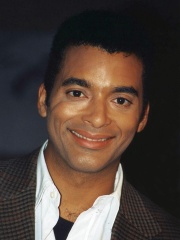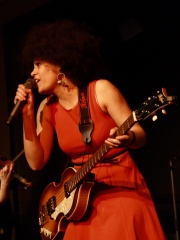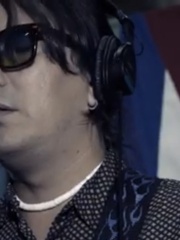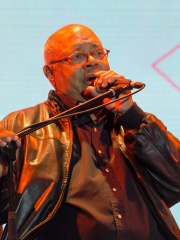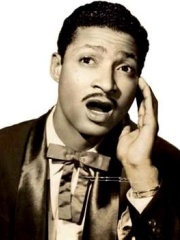
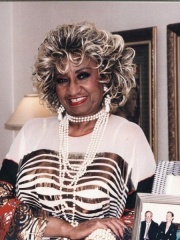
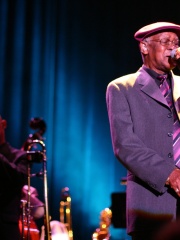
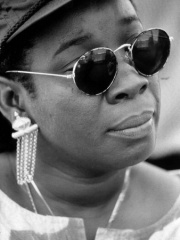
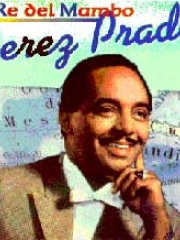
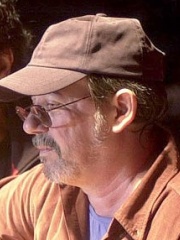

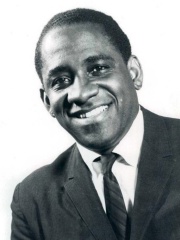
The Most Famous
SINGERS from Cuba
Top 10
The following people are considered by Pantheon to be the top 10 most legendary Cuban Singers of all time. This list of famous Cuban Singers is sorted by HPI (Historical Popularity Index), a metric that aggregates information on a biography's online popularity. Visit the rankings page to view the entire list of Cuban Singers.

1. Gloria Estefan (b. 1957)
With an HPI of 69.44, Gloria Estefan is the most famous Cuban Singer. Her biography has been translated into 64 different languages on wikipedia.
Gloria María Milagrosa Estefan (Spanish pronunciation: [ˈɡloɾja esˈtefan]; née Fajardo García; born September 1, 1957) is a Cuban-American singer, songwriter, actress, and businesswoman. Estefan is a four-time Grammy Award winner and a Presidential Medal of Freedom recipient, and has been named one of the Top 100 greatest artists of all time by both VH1 and Billboard. Estefan's record sales exceed 100 million worldwide, making her one of the best-selling music artists of all time. A contralto, Estefan started her career as lead singer of Miami Latin Boys, which was later renamed Miami Sound Machine. She and Miami Sound Machine earned worldwide success with their 1985 single "Conga", which became Estefan's signature song. The group followed this with a number of hit singles throughout the decade, including "Anything for You", "1-2-3", "Bad Boy", and "Rhythm Is Gonna Get You". The group was redubbed as Gloria Estefan and Miami Sound Machine with the release of their 1987 album Let It Loose, and in 1989, Estefan rose to solo stardom with her debut solo album, Cuts Both Ways. In March 1990, Estefan sustained a life-threatening cervical fracture of her spine when her tour bus was involved in a crash near Scranton, Pennsylvania. She underwent an emergency surgery and made a full recovery. The following year, Estefan launched her comeback with a worldwide tour and album, Into the Light. Estefan's 1993 Spanish-language album, Mi Tierra, won the first of her three Grammy Awards for Best Tropical Latin Album. The album was also the first Diamond album in Spain. Estefan's catalog of international solo hits includes "Don't Wanna Lose You", "Get On Your Feet", "Coming Out of the Dark", "Turn the Beat Around", "You'll Be Mine (Party Time)", and "Heaven's What I Feel". Estefan has been awarded a star on the Hollywood Walk of Fame and Las Vegas Walk of Fame and was a Kennedy Center Honors recipient in 2017 for her contributions to American cultural life. Estefan won an MTV Video Music Award, was honored with the American Music Award for Lifetime Achievement and has been named BMI Songwriter of the Year. She was inducted into the Songwriters Hall of Fame and has received multiple Billboard Music Awards. She is also a recipient of the 2015 Presidential Medal of Freedom, which was conferred by the then-President of the United States, Barack Obama. Billboard has listed Estefan as the third-most successful Latina and 23rd-greatest Latin Artist of all time in the U.S., based on both Latin albums and Latin songs chart. Hailed as the "Queen of Latin Pop" and "Mother of Latin Pop" by the media, she has amassed 38 number one hits across Billboard charts, including 15 chart-topping songs on the Hot Latin Songs chart.

2. Celia Cruz (1925 - 2003)
With an HPI of 68.31, Celia Cruz is the 2nd most famous Cuban Singer. Her biography has been translated into 51 different languages.
Celia Caridad Cruz Alfonso (21 October 1925 – 16 July 2003), known as Celia Cruz, was a Cuban singer and one of the most popular Latin artists of the 20th century. Cruz rose to fame in Cuba during the 1950s as a singer of guarachas, earning the nickname "La Guarachera de Cuba". In the following decades, she became known internationally as the "Queen of Salsa" due to her contributions to Latin music. She had sold over 30 million records, making her one of the best-selling Latin music artists. The artist began her career in her home country Cuba, earning recognition as a vocalist of the popular musical group Sonora Matancera, a musical association that lasted 15 years (1950–1965). Cruz mastered a wide variety of Afro-Cuban music styles including guaracha, rumba, afro, son and bolero, recording numerous singles in these styles for Seeco Records. In 1960, after the Cuban Revolution caused the nationalization of the music industry, Cruz left her native country, becoming one of the symbols and spokespersons of the Cuban community in exile. Cruz continued her career, first in Mexico, and then in the United States, the country that she took as her definitive residence. In the 1960s, she collaborated with Tito Puente, recording her signature tune "Bemba colorá". In the 1970s, she signed for Fania Records and became strongly associated with the salsa genre, releasing hits such as "Quimbara". She often appeared live with Fania All-Stars and collaborated with Johnny Pacheco and Willie Colón. During the last years of her career, Cruz continued to release successful songs such as "La vida es un carnaval" and "La negra tiene tumbao". Her musical legacy is made up of a total of 37 studio albums, as well as numerous live albums and collaborations. Throughout her career, she was awarded numerous prizes and distinctions, including two Grammy Awards and three Latin Grammy Awards. In addition to her prolific career in music, Cruz also made several appearances as an actress in movies and telenovelas. Her catchphrase "¡Azúcar!" ("Sugar!") has become one of the most recognizable symbols of salsa music.

3. Ibrahim Ferrer (1927 - 2005)
With an HPI of 66.78, Ibrahim Ferrer is the 3rd most famous Cuban Singer. His biography has been translated into 38 different languages.
Ibrahim Ferrer (20 February 1927 – 6 August 2005) was a Cuban singer who played with the group Los Bocucos for nearly forty years. He also performed with Conjunto Sorpresa, Chepín y su Orquesta Oriental, and Mario Patterson. After his retirement in 1991, he was brought back in the studio to record with the Afro-Cuban All Stars and Buena Vista Social Club, in March 1996. He then toured internationally with these revival groups and recorded several solo albums for World Circuit, before his death in 2005.

4. Rita Marley (b. 1946)
With an HPI of 65.58, Rita Marley is the 4th most famous Cuban Singer. Her biography has been translated into 27 different languages.
Alfarita Constantia Marley (née Anderson; born 25 July 1946) is a Jamaican reggae singer. She is the widow of reggae musician Bob Marley. Along with Marcia Griffiths and Judy Mowatt, Rita was a member of the reggae vocal group the I Threes, and the backing vocalists for Bob Marley and the Wailers.
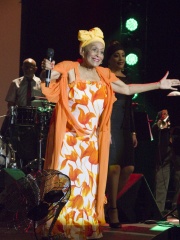
5. Omara Portuondo (b. 1930)
With an HPI of 63.29, Omara Portuondo is the 5th most famous Cuban Singer. Her biography has been translated into 27 different languages.
Omara Portuondo Peláez (born 29 October 1930) is a Cuban singer and dancer. A founding member of the popular vocal group Cuarteto d'Aida, Portuondo has collaborated with many important Cuban musicians during her long career, including Julio Gutiérrez, Juanito Márquez and Chucho Valdés. Although primarily known for her rendition of boleros, she has recorded in a wide range of styles from jazz to son cubano. Since 1996, she has been part of the Buena Vista Social Club project, touring extensively and recording several albums with the ensemble. She won a Latin Grammy Award for Best Contemporary Tropical Album in 2009, a Latin Grammy Award for Best Traditional Tropical Album in 2023, a Latin Grammy Lifetime Achievement Award in 2019, and she received three Grammy Award nominations in 2019 and a nomination in 2024.

6. Pérez Prado (1916 - 1989)
With an HPI of 62.74, Pérez Prado is the 6th most famous Cuban Singer. His biography has been translated into 30 different languages.
Dámaso Pérez Prado (December 11, 1916 – September 14, 1989) was a Cuban bandleader, pianist, composer and arranger who popularized the mambo in the 1950s. His big band adaptation of the danzón-mambo proved to be a worldwide success with hits such as "Mambo No. 5", earning him the nickname "The King of the Mambo". In 1955, Pérez Prado and his orchestra topped the charts in the US and UK with a mambo cover of Louiguy's "Cherry Pink (and Apple Blossom White)". He frequently made brief appearances in films, primarily of the rumberas genre, and his music was featured in films such as La Dolce Vita. Pérez Prado began his career as pianist and arranger for the Sonora Matancera, an internationally successful dance music ensemble from his hometown of Matanzas. He later established his own group and made several recordings in Havana in 1946, including "Trompetiana", a self-penned mambo and one of the first examples arranged for big band. He then moved to Mexico where he developed this particular genre in multiple forms, including bolero-mambo (with María Luisa Landín), guaracha-mambo (with Benny Moré) and two forms of instrumental mambo he created: mambo batiri and mambo kaen. The success of his 1949 recordings landed him a contract with RCA Victor in the US, which led to a prolific career during the 1950s. His number 1 hit "Cherry Pink (and Apple Blossom White)" was followed by other charting singles, such as a cover of "Guaglione" and his own "Patricia", both released in 1958. Pérez Prado's popularity in the US began to decline in the 1960s with the advent of other Latin dance rhythms such as pachanga and, later, boogaloo. Despite several innovative albums and a new form of mambo he called "dengue", Pérez Prado was never able to duplicate his earlier success and returned to Mexico in the 1970s, where he became a naturalized citizen in 1980. He died in Mexico City in 1989. His son, Pérez Prado Jr., continues to direct the Pérez Prado Orchestra in Mexico City to this day.

7. Silvio Rodríguez (b. 1946)
With an HPI of 61.50, Silvio Rodríguez is the 7th most famous Cuban Singer. His biography has been translated into 29 different languages.
Silvio Rodríguez Domínguez (born 29 November 1946) is a Cuban musician, and leader of the Nueva Trova movement. He is widely considered as Cuba's best folk singer and arguably one of Latin America's greatest singer-songwriters. Known for his intellectual, highly eloquent and symbolic lyrics, his songs are iconic elements of Latin American left-leaning popular culture. Many of his songs have become classics in Latin American music, such as "Ojalá", "Playa Girón", "Unicornio", "Sueño con Serpientes", "Vamos a andar," and "La maza". Among his other well-known songs are political anthems like "Fusil contra fusil" and "Canción del Elegido", and poetic melodies like "A donde van" and "Noche sin fin y mar". He has released over 20 albums. Rodríguez, musically and politically, is a symbol of the Latin American left. His lyrics are notably introspective, while his songs combine romanticism, eroticism, existentialism, revolutionary politics and idealism. As a humanist, his songs often bespeak a secular worldview, where humanity must make the best of this world.

8. Camila Cabello (b. 1997)
With an HPI of 61.41, Camila Cabello is the 8th most famous Cuban Singer. Her biography has been translated into 73 different languages.
Karla Camila Cabello Estrabao (; Latin American Spanish: [ˈkaɾla kaˈmila kaˈβeʝo esˈtɾaβao]; born March 3, 1997) is an American singer and songwriter. She rose to prominence as a member of the pop girl group Fifth Harmony, one of the best-selling girl groups of all time. While in the group, Cabello established herself as a solo artist with collaborative singles "I Know What You Did Last Summer" (with Shawn Mendes) and "Bad Things" (with Machine Gun Kelly), the latter making number four on the US Billboard Hot 100. She left Fifth Harmony in late 2016. Cabello's debut studio album, Camila (2018), peaked atop the US Billboard 200. Largely influenced by Latin music, its lead single "Havana" (featuring Young Thug) was an international chart-topper. It was the best-selling digital single of 2018, according to the International Federation of the Phonographic Industry (IFPI). Its follow-up, "Never Be the Same" reached the top ten in multiple countries. Cabello's second album Romance (2019) peaked at number three on the Billboard 200 and spawned a second global chart-topper in "Señorita", a duet with Shawn Mendes. Cabello's third album Familia (2022), made number ten on the Billboard 200 and contained the international hit "Bam Bam" (featuring Ed Sheeran). Cabello's fourth studio album, C,XOXO, was released in 2024. Cabello's awards include two Latin Grammy Awards, five American Music Awards, and one Billboard Music Award. In 2021, Cabello starred as the title character in the film Cinderella.

9. Mongo Santamaría (1917 - 2003)
With an HPI of 61.27, Mongo Santamaría is the 9th most famous Cuban Singer. His biography has been translated into 21 different languages.
Ramón "Mongo" Santamaría Rodríguez (April 7, 1917 – February 1, 2003) was a Cuban percussionist and bandleader who spent most of his career in the United States. Primarily a conga drummer, Santamaría was a leading figure in the pachanga and boogaloo dance crazes of the 1960s. His biggest hit was his rendition of Herbie Hancock's "Watermelon Man", which was inducted into the Grammy Hall of Fame in 1998. From the 1970s, he recorded mainly salsa and Latin jazz, before retiring in the late 1990s. Mongo learned to play the congas as an amateur rumba musician in the streets of Havana. He then learned the bongos from Clemente "Chicho" Piquero and toured with various successful bands such as the Lecuona Cuban Boys and Sonora Matancera. In 1950, he moved to New York City, where he became Tito Puente's conguero and in 1957 he joined Cal Tjader's band. He then formed his own charanga, while at the same time recording some of the first rumba and Santería music albums. By the end of the decade, he had his first pachanga hit, "Para ti". He then became a pioneer of boogaloo with "Watermelon Man" and later signed record deals with Columbia, Atlantic and Fania. He collaborated with salsa artists and became a member of the Fania All-Stars, often showcasing his conga solos against Ray Barretto. In his later years, Santamaría recorded mostly Latin jazz for Concord Jazz and Chesky Records.
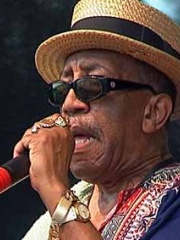
10. Laurel Aitken (1927 - 2005)
With an HPI of 58.99, Laurel Aitken is the 10th most famous Cuban Singer. His biography has been translated into 19 different languages.
Lorenzo "Laurel" Aitken (22 April 1927 – 17 July 2005) was a Cuban-Jamaican singer and one of the pioneers of ska music. He is often referred to as the "Godfather of Ska".
People
Pantheon has 18 people classified as Cuban singers born between 1916 and 1997. Of these 18, 10 (55.56%) of them are still alive today. The most famous living Cuban singers include Gloria Estefan, Rita Marley, and Omara Portuondo. The most famous deceased Cuban singers include Celia Cruz, Ibrahim Ferrer, and Pérez Prado.
Living Cuban Singers
Go to all RankingsGloria Estefan
1957 - Present
HPI: 69.44
Rita Marley
1946 - Present
HPI: 65.58
Omara Portuondo
1930 - Present
HPI: 63.29
Silvio Rodríguez
1946 - Present
HPI: 61.50
Camila Cabello
1997 - Present
HPI: 61.41
Jon Secada
1961 - Present
HPI: 54.01
Addys Mercedes
1985 - Present
HPI: 53.45
Mayra Andrade
1985 - Present
HPI: 47.11
Chanel Terrero
1991 - Present
HPI: 46.71
Diego Gutiérrez
1974 - Present
HPI: 45.54
Deceased Cuban Singers
Go to all RankingsCelia Cruz
1925 - 2003
HPI: 68.31
Ibrahim Ferrer
1927 - 2005
HPI: 66.78
Pérez Prado
1916 - 1989
HPI: 62.74
Mongo Santamaría
1917 - 2003
HPI: 61.27
Laurel Aitken
1927 - 2005
HPI: 58.99
Pablo Milanés
1943 - 2022
HPI: 58.83
Benny Moré
1919 - 1963
HPI: 58.44
Olga Guillot
1922 - 2010
HPI: 54.31
Overlapping Lives
Which Singers were alive at the same time? This visualization shows the lifespans of the 8 most globally memorable Singers since 1700.

